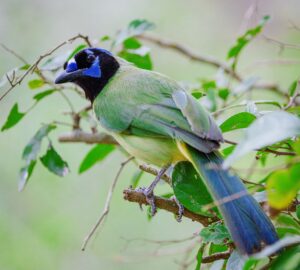
Photo by Mark Olsen on Unsplash
We’re fondly aware of our well-known and much-loved blue jay. They’re commonly found in the Eastern regions of North America. Its array of stained-glass-like blues and whites on its body along with the familiar blue crest makes it a bird of extra note in the wild. Its cousin, the Stellar’s jay found in the western regions of the U.S. is as distinctive and pleasant to look at as its cousin. Both birds are plentiful and not with concern for depletion. Of course, there are several birds included within the jay family, but they aren’t as vibrantly colored and remembered as readily. But there is one that we are typically unaware of simply because they live further south within Mexico and Central America. This is the green jay.
Green Jays on the Move
The green jay has only previously been spotted as far north as the deep south of Texas bordering Mexico. As the green jay is a non-migratory species, it is realized that it is perfectly satisfied with its resident locations where it thrives. These beautiful birds are highly recognizable for their yellow-white feathers, and the patch of dark blue on their heads. Their upper regions are a deep green color, with their belly regions colored lighter green. But something curious is occurring. They seem to be moving north a bit.
eBird, an online database that monitors and catalogs birds and tracks sightings of those birds has recently updated with the news that the green jay has been sighted in San Antonio and other more northern towns. It appears that they’re liking the developing softer winters that are now common inside southern Texas. It likely reminds them of the home they have typically lived in so…why not a new spot, a new home. Right? Humans do it all the time.
Even more fascinating is the recent sighting of a possible hybrid of a blue jay and a green Jjay. Sighted within the confines of San Antonio, the odd bird was at a feeder and captured by a graduate student from Austin for closer genetic study. It has been photographed and posted with interest. And so, it seems that the blue jay is checking out the southern regions of the U.S. more than they previously have. And with that, it is inevitable that the two birds would come into contact eventually.
Climate Driving Relocations?
As climate change occurs, many instances of relocation occur naturally as tantalizing discoveries for the birds. They begin to find suitable habitats in which to start fresh. With our exponentially growing interests in birdwatching, and the development and fast growth of technologies enabled to mark these occurrences, we’re finding rapid change within every facet of the natural world. Like humans, birds are learning to adapt within a broader stage that suits their needs. If it begins to get too hot in one place, and the climate has provided a suitable location elsewhere nearby, the birds will take advantage of it to survive.
Those green jays are beautiful and a new addition to my lexicon.

7 Comments